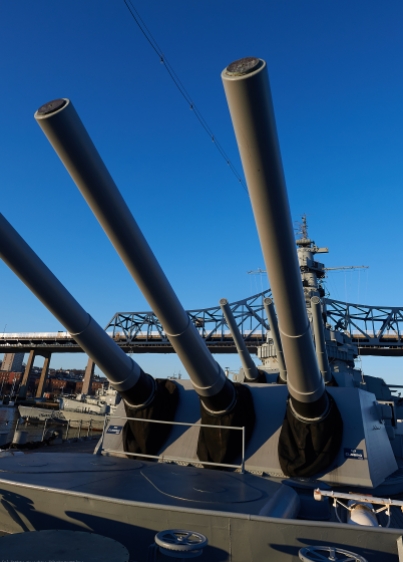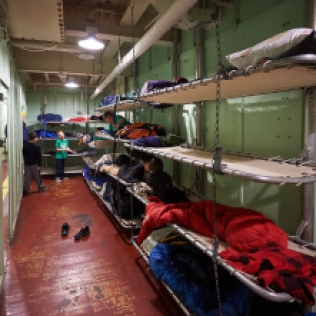Not so secretly, I quite looked forward to my night on the Battleship USS Massachusetts even though I’d been warned about the sleeping arrangements. How often does such an opportunity arise? The ship in question was built between 1939 and May of ’42 when it sailed for Casablanca and the fight against the Nazis in North Africa. There it would cripple the Vichy French battleship Jean Bart in a gun duel during Operation Torch. It would carry over 2,300 sailors in it’s prime, pass through the Panama Canal, and then fight in the Pacific… though this particular evening it would be saddled with “only” 500 or so cub scouts and parents at its current home in Fall River, MA.


Not that a 680 foot long ship wouldn’t be interesting enough, this floating museum includes a WWII vintage submarine, and two ’50s/’60s vintage destroyers, one U.S. and one Russian, and two PT boats. However, the biggest interests among our group of seven year olds were the sub and “Big Mamie” (USS Massachusetts).
The scale of Battleship is nearly impossible to fathom without crawling through its four or five levels of catacombs and sitting inside a 16″ gun turret. The level of detail and analog ingenuity shows up at every turn, and to imagine all of this design being done without computers. Amazing. But first those big guns: The USS Massachusetts has 9 of them. Each turret hosts three, two turrets face forward and one faces aft. The shells are a foot taller than my 7 year old and weigh 2,700 lbs each.
Inside one of those turrets you find a massive array of analog “tech”. Rusted switches, whose purpose may only be found on a blueprint somewhere. Aiming mechanisms and a giant push arm which rams the charge (gunpowder), behind the shell into the 16″ barrel to prep for firing.
The shells come straight up from three floors below. Below you can see the curved gap in the floor where the turret rotates surrounded by the 1.3 ton shells.

Between two of the levels, the ship has a 7″ thick sheet of steel running the length of the ship. It’s meant to protect the important stuff below like the engine room, the boilers, etc.
Spending some 17 hours on the ship, we actually started to feel comfortable knowing our way around, but still couldn’t imagine 2,300 sailors sharing the space. The mess hall was large but not that large. Our 500 cub scouts needed three seatings to get through.
Of course, what makes all this interesting is the history. Battleships became obsolete after WWII: They were incredibly expensive to run ($2m per day in fuel in 1952), and air power had taken over as the weapon of choice. But for a brief period, these floating, armed-to-the-hilt cities were masters of their domain. The USS Massachusetts never lost a man in battle and it saw many. It is claimed to be the ship which fired the first and last 16″ shells ‘in anger’ during the WWII.
The summary stats of the ship can be found on two plaques:
Of course, at the end of the day, we all needed to (try to) sleep. Accommodations were accurate, perhaps a little too accurate? Canvas bunks, stretched to aluminum frames stacked four high. Kids climbed and bounced and found endless ways to entertain. Adults? We just struggled and contorted our not-so-flexible torsos just to get in.
That struggle was made more challenging by our location near the “head” and what seemed like a variety of pumps and heaters which vibrated, whistled, hummed and clanked to no end. 2:30 am was memorable for a certain high pitched, high decibel whine that lasted about 5 minutes and then disappeared for good. But 5 minutes was all it took.
In the morning, the adults managed to commiserate once we found coffee. Few needed a wake up call, the kids were up at 5:30 and some of us didn’t get back to sleep after 2:30’s rude awakening. My son and I took advantage of the the early rise by getting outside where the fire-hose rack seems to smile at us.
After breakfast, a group of us ventured to explore the submarine, USS Lionfish, in more detail. The Lionfish saw action at the very end of WWII as described here and was decommissioned in 1951.
What I didn’t know about subs of that era is that they ran on electricity when submerged. The diesels were fired up when sailing at sea level, propelling the sub and charging the batteries. Of course it makes sense when you think about it, as the diesel exhaust would leave an obvious trail in the water from above.
The Lionfish has a single corridor running the length of the ship, torpedo silos exist at both ends. Here you can see two torpedoes at rest, waiting to be pushed into the launch tube. The launch tube can be seen below.


In the middle of the ship, you get a feel for the power and control areas. A plexiglass engine cutout gives a glimpse of a long crankshaft, amp meters show that status of battery power, a depth gauge showing 60′ of water below the keel.
Probably what stuck with me most from the trip was the talk from one of the actual crew members of the USS Massachusetts. The sailor, now in his mid-nineties, spoke at the orientation. He was Boston-sharp, engaging and refreshingly honest. His stint on the vessel lasted for five years, including its entire WWII run in both the Atlantic and Pacific theatres.
One person asked: “What do you think of the ship now?”
He paused briefly as if to consider being diplomatic, but then didn’t hold back at all: “you mean as it exists now? oh, it makes me very sad. You should have seen it when it was running and clean and well kept. Yeah, it’s sad to see it this way, it really is“.
We visitors can only try to imagine an immaculate ship, with no rust, and bustling with activity. You’ve gotta wonder how they keep these vessels from rusting out now, but you hope they do. I find these monuments surprisingly fascinating and worth preserving if nothing else. Maybe as we age we appreciate history more? Regardless, they remind us what we can engineer when we have to, though I still have no idea how those sailors “engineered” a good night sleep.
































